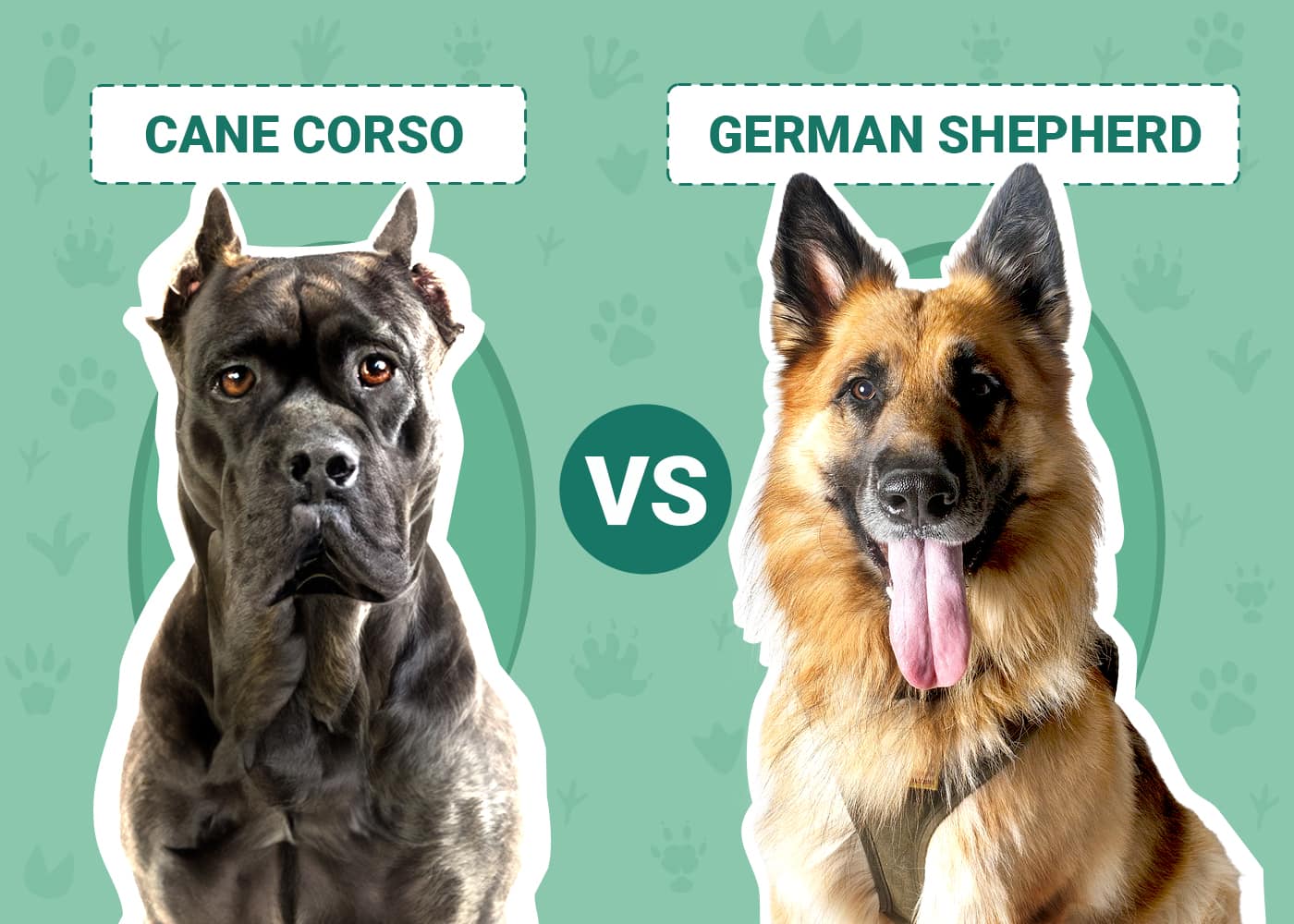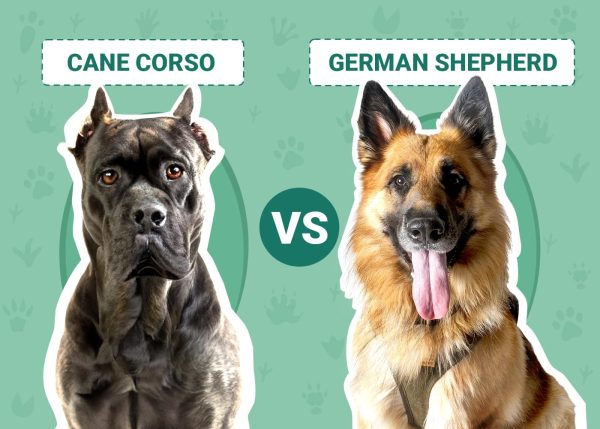Click to Skip Ahead
While the Cane Corso and German Shepherd may be two different dog breeds, it’s fair to say that they have been excelling at keeping homes and families safe for several decades now. These dogs are bred to watch over their posts, observing and guarding their environment against potential intruders with their menacing demeanor and intimidating stare.
These two breeds may have so much in common, but they also feature physical differences and have different backgrounds. This is probably why potential dog owners go through a hard time figuring out which breed is best suited for their homes.
However, both are best suited for owners looking for fiercely protective and loyal dogs. In this article, we will give you a glimpse into what these two breeds can offer. Read on to learn more.
Visual Differences

At a Glance
- Average height (adult): 23½–27½ inches
- Average weight (adult): 88–110 pounds
- Lifespan: 10–11 years
- Exercise: High to very high intensity
- Grooming needs: Moderate
- Family-friendly: Yes, and very good
- Other pet-friendly: Sometimes
- Trainability: Affectionate, loving, eager to please
- Average height (adult): 22–26 inches
- Average weight (adult): 75–95 pounds
- Lifespan: 10–14 years
- Exercise: High intensity
- Grooming needs: Moderate
- Family-friendly: Yes, and very good
- Other pet-friendly: Always
- Trainability: Thrives on exercise training and enjoys mental stimulation
Cane Corso Overview
The Cane Corso hails from an ancient breed of working canines. For centuries, this breed has been used in Italy as hunters, herders, and guards. In fact, the name “Cane Corso” actually means a “guarding dog” in Latin.
It is believed that this dog breed was introduced in America in the late 80s and quickly became a popular breed among large dog enthusiasts, mostly because of their imposing physique. They were recognized as a purebred working dog by the AKC in 2010.

Temperament
If you are looking for an assertive dog breed, the Cane Corso checks the box. Like other mastiff breeds, the Cane Corso can be bull-headed and strong-willed. Yet, they are the most attentive and cooperative of the mastiff breeds, and most people consider them easier to train. But they tend to gravitate towards dominance aggression, thus requiring an owner who is self-assured enough to command the dog’s respect.
Under the wrong care, the Cane Corso can grow to be a very dangerous dog. If poorly bred, they can develop overly aggressive behaviors and would end up attacking people even when unprovoked or even become skittish and bite whenever they feel fear.
But a well-bred Cane Corso should be calm and alert around strangers. The dog’s no-nonsense demeanor is threatening enough to deter potential intruders without necessarily having to attack.
Generally, Cane Corsos are affectionate and loyal, and they bond strongly with their families. They also have the instinct to protect their primary caregivers and their families. They only become destructive if they get bored or are left to their own devices for a long time.
Exercise Needs
This breed is perfectly capable of keeping up with some outdoor activities like jogging, hiking, and training sessions in your compound. Generally, they will thrive with just 60 minutes of exercise per day, but it’s best to consult your local vet for recommendations.
With an impressive background as a hunting dog, the Cane Corso is not meant to lounge around your house. Large dog breeds like this often suffer from weight-related medical issues, which can be detrimental to their health. Therefore, you should encourage and push your dog to move around and stretch their legs.
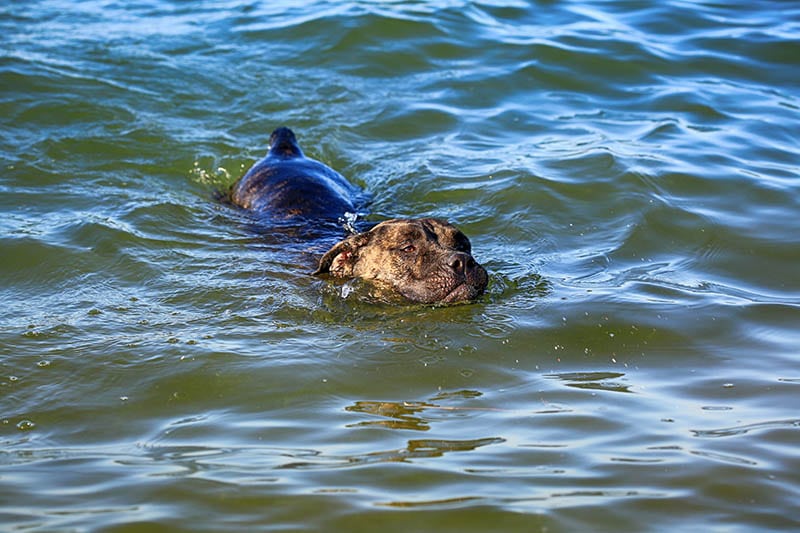
Training
Since Cane Corsos are an intelligent dog breed, it shouldn’t come as a surprise that they are highly trainable. However, they are easier to train from the puppy stage because of their protective tendencies and overall large size.
They must be socialized with other pets, dogs, and people from a very young age to avoid aggressive tendencies later on in life. Also, their large muscular bodies would prove difficult to control if they started misbehaving as adults.
While training, the owners need to exercise authority and consistency to ensure that the dog is properly socialized to be family-oriented.
Thankfully, Cane Corso’s are eager to please their owners, which simplifies the training regimen. If your Cane Corso is not properly socialized, it would be best to keep them at home, away from people, and where they would feel comfortable and safe.
Health and Care
Just like humans, no dog is 100% free from medical issues. Sure, the Cane Corso is generally a healthy dog breed, but at one point in their life, they will develop or experience serious to mild health issues, requiring immediate help from veterinary professionals.
Be on the lookout for the following common health problems:
- Eyelid abnormalities: The dog’s eyes can droop outward in a condition known as ectropion or even droop inside in entropion.
- Cherry eye: This happens when a gland found in the third eyelid prolapses.
- Demodex: This is a type of mange brought on by certain mites that burrow in the skin of your dog when his immune system is compromised.
- Arthritis: This is brought on by joint and elbow issues
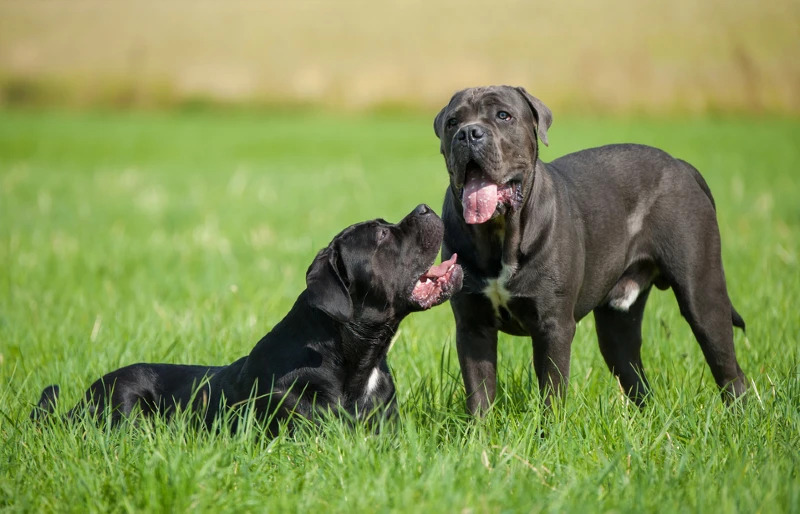
Grooming Requirements
Fortunately, the grooming needs of Cane Corso are not as tasking, as they are a moderate shedder, except during the fall and spring seasons. Other than the seasonal shedding, your Cane Corso will be good with a bath after 6 to 8 weeks and a weekly brush.
However, you have to exercise caution when cleaning your dog’s skin and coat. For their safety, consider using only mild canine products to avoid skin allergies and other undesirable conditions on their coat.
Suitable For:
This dog breed is ideal for a household that wants a massive protective dog. The owner has to be willing to physically exert the dog to expend their high energy levels and extensively socialize the dog so that they can amicably get along with other household members.
With proper care and maintenance, you can have a loyal companion for close to 10 years in a Cane Corso.
German Shepherd Overview
The German Shepherd is one of the youngest members of the shepherd dog family. They were initially bred to herd livestock, but as herding lost their usefulness in the modern world, they emerged as one of the most versatile working dog breeds. They were among the first breeds to gain recognition by AKC and were registered in 1908.
Due to the German Shepherd’s sharp senses and superior intellect, they are often used as a service dog, and you can find the dog employed in healthcare, rescue, search, and law enforcement agencies worldwide.
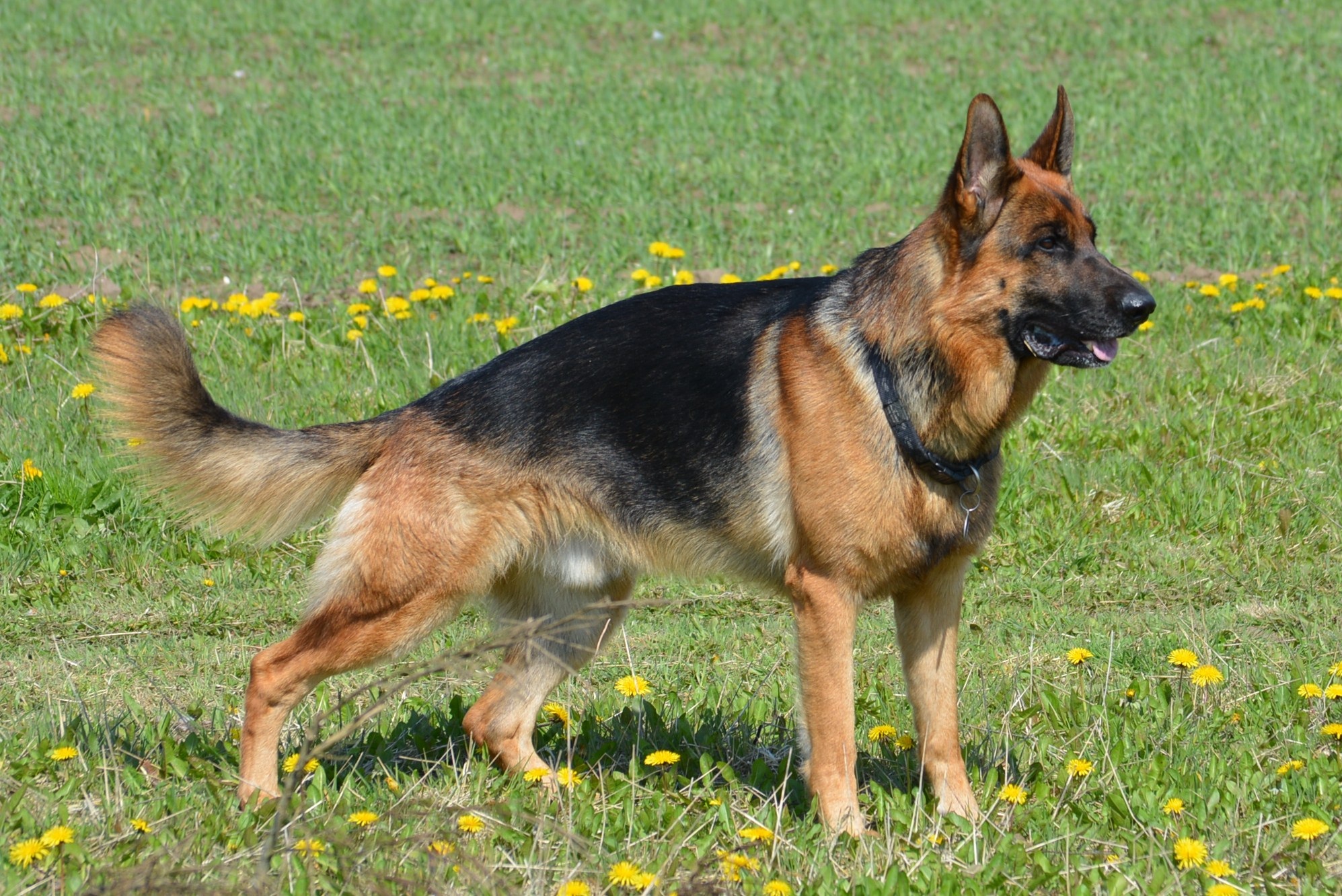
Temperament
German Shepherds are some of the most intense, courageous, loyal, and intelligent breeds that you can own. The dog’s ability to focus and complete a task can be traced back to their herding origins.
Unlike Cane Corso, which can bond with all members of a household, German Shepherds tend to bond with only one family member, usually the primary caregiver.
Improper breeding practices can produce German Shepherds that fear-bite or are shy and cowardly. You could end up owning a dog that is threatening, excessively suspicious of strangers, and can even attack without provocation.
However, if a German Shepherd is raised in a properly socialized environment, they can be indifferent or distantly polite to visitors in your home. This breed is also instinctively protective of their family and property, even without formal guard training. And with consistent training, they can learn to get along with children. Some even learn how to be gentle with infants.
Exercise Needs
As earlier mentioned, German Shepherds are quick learners and enjoy doing various tasks. This is largely due to the dog’s history, which has a huge impact on how the dog behaves today. Therefore, as a potential owner, you have to commit to providing your canine companion with an active lifestyle to keep their mental faculties stimulated.
If your German Shepherd is not raised as a working dog, they will do well with at least 60 minutes worth of exercise every day. However, you should divide the exercise time into smaller sessions to avoid over-exhausting your dog. Moreover, both physical and mental stimulation should happen regularly to keep your dog fit and healthy.
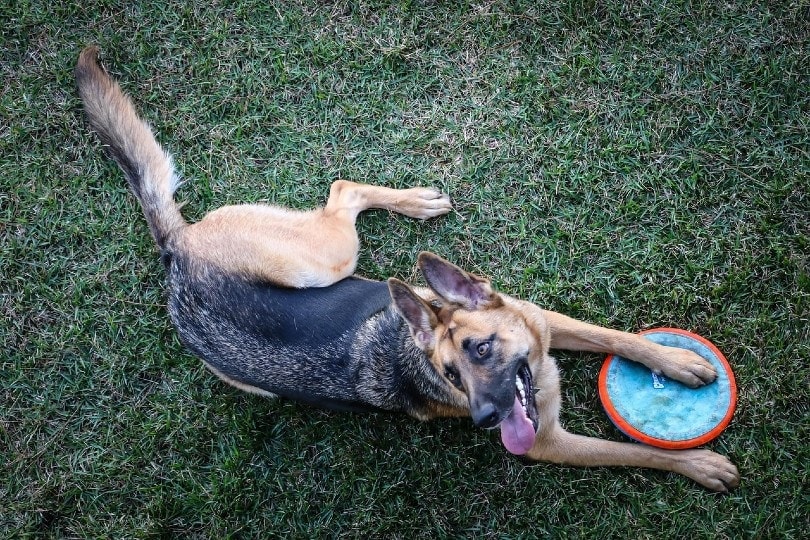
Training
Due to their extreme intelligence, German Shepherds can undergo extensive training programs. They can even learn several commands and words, which only adds to their trainability. This is perhaps why they are frequently used in the police force.
When properly trained, this breed can be a well-behaved lifelong companion. But keep in mind that for the training to be effective, it should start when the dog is still at the puppy stage because they can have aggressive tendencies. Thus, socializing them while still small and easy to handle is crucial for long-term success.
Health and Care
Generally, German Shepherds are a healthy breed, especially if they come from a responsible and reputable breeder. However, some of them can still experience various medical issues, which fortunately are treatable. The most common health conditions in German Shepherds (and not necessarily in Cane Corso’s) include:
- Degenerative myelopathy: A progressive neural condition that is autoimmune based
- Perianal fistula: Occurs when the draining tracts are infected
- Cryptorchidism: Occurs when one or both testicles do not descend
- Eye problems: Mostly pannus and retinal atrophy
- Bloat
- Diabetes
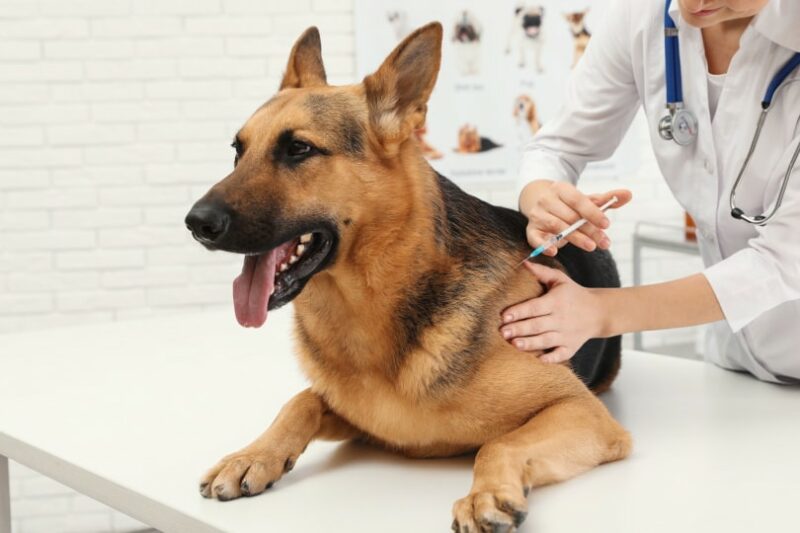
Grooming Requirements
As dogs who feature a medium-length coat, German Shepherds will need daily brushing to keep them clean and dander free. However, spare your dog daily baths, but you can schedule one after every 2-3 months or whenever you deem it necessary.
As with most grooming routines, you should also trim your dog’s nail every month to prevent them from overgrowing and limiting movement. While grooming, you should also check their ears and teeth for any signs of infections.
Suitable For:
German Shepherds are an ideal dog breed for anyone looking for a loyal and protective family dog. They can also be trained to tackle various tasks around your home.
They are also suitable for people looking for an all-rounded dog with many strengths that they can train for competitive purposes.
However, being heavy shedders, German Shepherds are not ideal for people suffering from allergic reactions.
Key Differences and Similarities
Size
Generally, Cane Corso’s are larger dogs when compared to German Shepherds. The Cane Corso features a muscular, stocky, and heavy body, while the German Shepherds are smaller and leaner.
Health
Canine experts believe that a Cane Corso is slightly healthier and has a longer lifespan when compared to a German Shepherd. While the German Shepherd can live for 7–10 years, Corso’s can live 9–12 years. Both breeds are susceptible to hip and elbow dysplasia, which is an abnormal growth of their joints.
Temperament
Both breeds are brilliant, very trainable and have similar temperaments. Sure, the Cane Corso might be more aggressive and protective, but the German Shepherd can learn more commands making them easier to keep in line whenever they misbehave.
Which Breed Is Right for You?
German Shepherds and Cane Corso can appeal to many people because they share a lot of similarities. However, to get one that is suitable for your family, there are several Key factors that you should consider. How many people live in your household? What is the purpose of your dog? How large a dog do you want?
If you want a snuggly, affectionate dog that makes you feel secure and safe, the Cane Corso would be your best bet. If you want a hardworking dog that can accompany you as you handle your daily job, you might want to go for the German Shepherd.
If you live in a home with smaller pets and children, the German Shepherd would be the best fit. But, if you lead a solitary life or have a stable and quiet home, you will benefit from the Cane Corso’s companionship.
Overall, these two dog breeds are similar in many ways, so the final choice will be up to you. Keep in mind that with proper socialization and training, both dogs can thrive and be amazing companions for your family.
See also:
- How Much Crude Protein Should Be in Dog Food? Vet Approved Facts & Advice
- 11 Best Dog Foods for IBD – Reviews & Top Picks
Featured Image Credit: (T) Nikola Parca, Shutterstock | (B) Shumilov Ludmila, Unsplash

